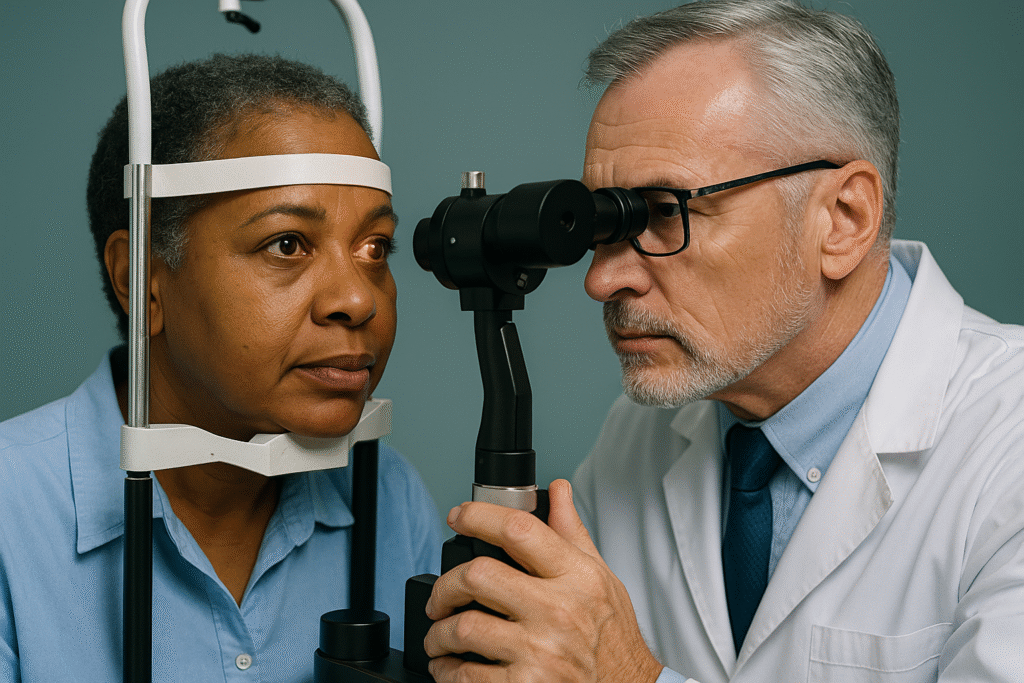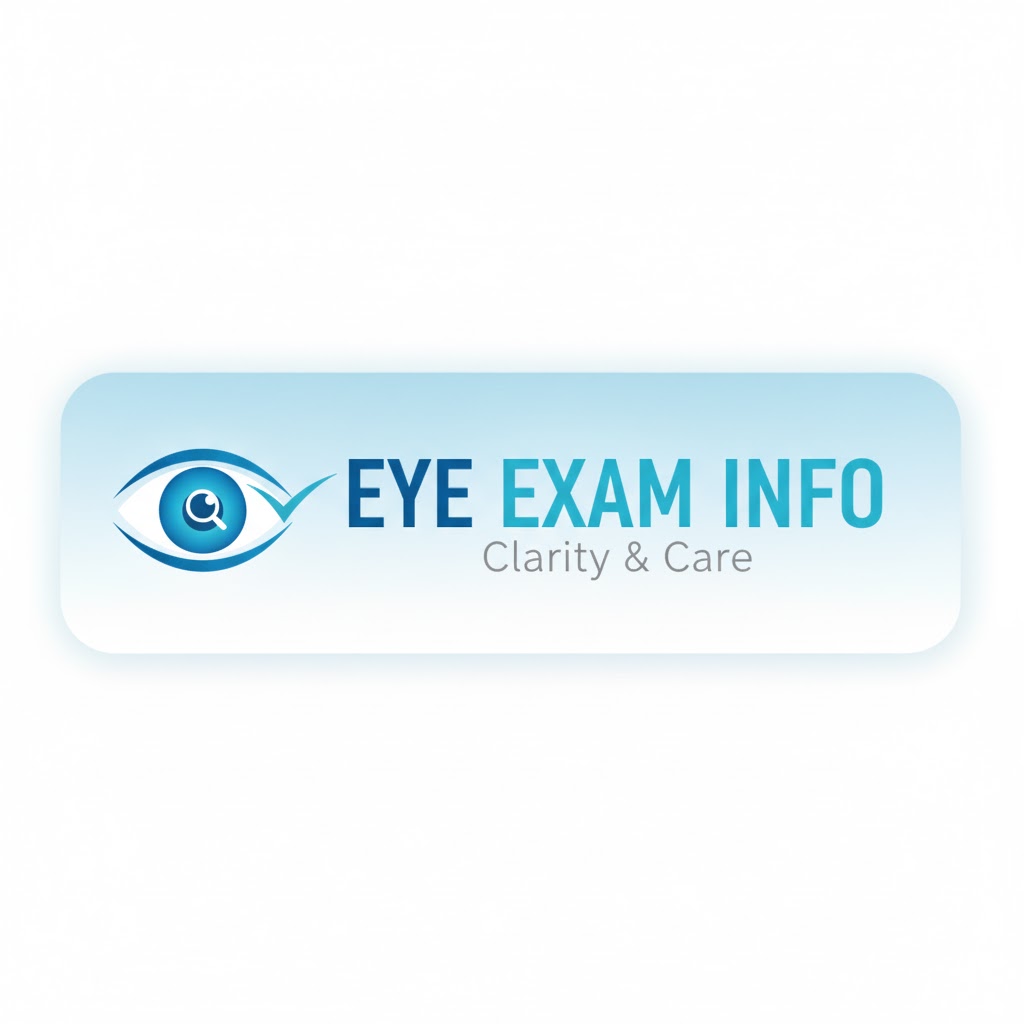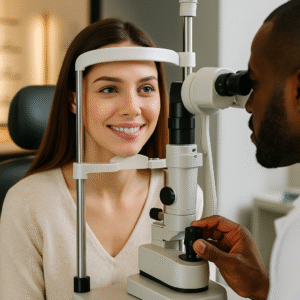Eye Doctor for Diabetic Eye Exam: Why It’s Crucial & Who You Should See (2025 Guide)

If you have diabetes, your eyes are at risk — even if your vision feels perfectly fine.
A diabetic eye exam is not just another vision test — it’s a life-saving diagnostic check that can prevent blindness and detect disease before symptoms appear.
In this 2025 guide, you’ll learn:
👁️ Which type of eye doctor you need
🩺 How diabetic eye exams work
💰 What insurance covers (and what doesn’t)
📍 Where to find diabetic-friendly eye doctors near you
What Is a Diabetic Eye Exam?
A diabetic eye exam is a specialized eye health evaluation that checks for damage to the blood vessels in the retina — a condition known as diabetic retinopathy.
Unlike a regular eye exam, this test focuses on the back of the eye (retina) to spot early signs of:
- Retinal swelling or bleeding
- Leaking blood vessels
- Scar tissue formation
- Nerve damage
- Early macular degeneration
💬 “Diabetic retinopathy often has no symptoms until vision loss occurs. Regular eye exams save sight.”
— American Diabetes Association (ADA)
👩⚕️ Which Eye Doctor Should You See for a Diabetic Eye Exam?
There are two main types of eye doctors — and both play different roles in diabetic eye care:
| Doctor Type | Role | When to See |
|---|---|---|
| Optometrist (OD) | Performs diabetic eye exams, monitors early-stage disease | Every 6–12 months |
| Ophthalmologist (MD) | Eye surgeon and specialist for advanced diabetic retinopathy | If bleeding or vision loss occurs |
💡 If you’re newly diagnosed with diabetes, start with an optometrist — they’ll refer you to an ophthalmologist if necessary.
🩸 Why Diabetic Eye Exams Are Critical
Diabetes damages small blood vessels in the retina over time — causing retinopathy, which can lead to permanent vision loss.
Regular eye exams help detect these changes before they affect your sight.
🚨 Without Early Detection:
- You risk sudden bleeding (vitreous hemorrhage)
- Scar tissue can pull the retina off (retinal detachment)
- Untreated cases lead to irreversible blindness
✅ With Early Detection:
- Eye drops, laser therapy, or injections can stop the disease from progressing
- You can save up to 95% of your vision with timely treatment
🔍 What Happens During a Diabetic Eye Exam
A diabetic eye exam is quick, painless, and typically takes 20–30 minutes.
Here’s what’s included:
- Visual Acuity Test: Checks how clearly you see.
- Pupil Dilation: Drops widen your pupils to view your retina.
- Retinal Imaging (Fundus Photography): High-resolution pictures detect leaks and swelling.
- Optical Coherence Tomography (OCT): 3D scan for retinal layer analysis.
- Fluorescein Angiography (if needed): Special dye highlights blood vessel leaks.
🧠 These tests can detect damage long before you notice any vision changes.
📅 How Often Should You Get a Diabetic Eye Exam?
| Patient Type | Frequency | Notes |
|---|---|---|
| Type 1 Diabetes | Within 5 years of diagnosis, then annually | Start early if diagnosed as an adult |
| Type 2 Diabetes | At diagnosis, then every year | Even if vision seems normal |
| Pregnant (with diabetes) | Before pregnancy and each trimester | Rapid hormonal changes affect retina |
| Existing Retinopathy | Every 3–6 months | More frequent monitoring needed |
💡 Skipping even one annual exam can allow irreversible changes to develop unnoticed.
💰 Cost & Insurance Coverage
| Exam Type | Average Cost (Without Insurance) | Covered By |
|---|---|---|
| Basic Diabetic Eye Exam | $120–$180 | Medical Insurance (Aetna, BCBS, Cigna, UHC) |
| Dilated Retinal Exam | $150–$250 | Medical Insurance |
| OCT or Fundus Scan | $200–$400 | Partial or full coverage |
| Follow-Up Visit | $90–$150 | Usually covered |
🧾 Billing Tip:
These are medical exams, not vision exams — your doctor will bill them under medical insurance (not vision) using codes like:
- CPT 92004 (Comprehensive eye exam)
- CPT 92250 (Fundus photography)
- CPT 92134 (OCT retinal scan)
Where to Find a Diabetic Eye Doctor Near You
When searching “eye doctor for diabetic eye exam near me,”
look for providers with experience in retina care or diabetic vision monitoring.
Top National Chains (U.S. 2025):
- LensCrafters Clarifye® Retina Exam
- Pearle Vision Retinal Scan Centers
- MyEyeDr. Diabetes Eye Health Clinics
- Walmart Vision Center (with Retina Imaging)
- America’s Best Contacts & Eyeglasses (Select Locations)
💬 Ask if they offer “digital retinal imaging” — it’s more accurate and doesn’t always require dilation.
Signs You Need an Immediate Diabetic Eye Exam
Don’t wait until your yearly checkup if you notice:
- Blurry or double vision
- Dark spots or floaters
- Flashes of light
- Sudden vision loss in one eye
- Eye pain or pressure
- Straight lines appearing wavy
🚨 These could signal bleeding or retinal detachment — seek emergency care immediately.
Diabetic Eye Exams – FAQ
Can any eye doctor do a diabetic eye exam?
Yes, both optometrists and ophthalmologists can — but make sure they use retinal imaging or dilation.
Does insurance cover diabetic eye exams?
Yes, they are billed as medical, not vision exams.
Is dilation required?
Usually, yes. However, digital imaging (Optomap, Clarifye) can sometimes replace it.
Can diabetes cause blindness?
Yes — diabetic retinopathy is a leading cause of blindness in U.S. adults, but early detection prevents 9 out of 10 cases.




Leave a Comment
Your comment will be published after it has been approved. Please send comments that do not contain slang words.